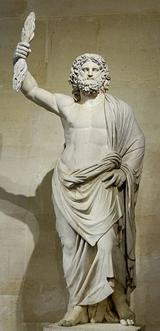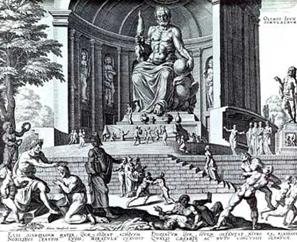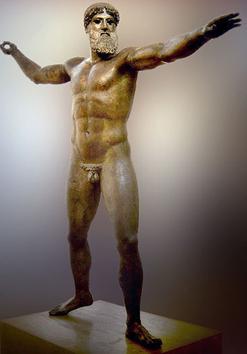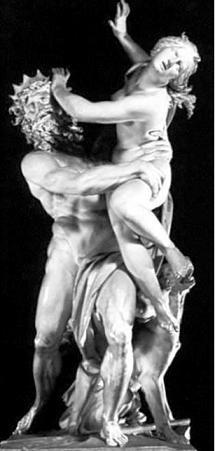


Artefact #1: Engraving of Zeus at Olympia- Philippe Galle.
This engraving of the Statue of Zeus at Olympia was made by Philippe Galle in 1572, obviously long after the time of the ancient Greeks. However, this depiction represents an incredibly important part of the history of Zeus. At Olympia, the site of the first Olympic Games and the present day location of the Olympic flame, there once stood a great temple dedicated to Zeus, and within it stood the great Statue of Zeus, as seen in Galle’s engraving. This statue was considered one of the Seven Wonders of the Ancient World. This artefact is incredibly interesting when examining one of Zeus’ particular roles in Greek society. Although Zeus did represent all of Greek Society, he was the god to whom the Olympic Games were dedicated. Competitors would compete for the glory of Zeus. We can see in this engraving, in the bottom right, two men wrestling at the foot of the statue. Wrestling was one of the key competitions in ancient Greek Olympics.
Though, the Olympics were not the only connection that this engraving depicts. We can also see many people in the act of worshipping before the great statue. As Zeus represented all of society and was the leader of the gods, he was arguably the primary figure of theology during that time period and was thus owed much respect.
The original statue of Zeus was crafted by Phidias in 432 BCE. It was made of ivory and gold-platted bronze. After the discovery of Phidias’ workshop in 1954, it was unearthed that the sculpture had used a description from Homer’s Iliad to design his magnificent work. The Statue is said to have remained in existence for 600 years after Phidias’ death. Everyone was encouraged to visit it at least once during their life, as it was considered a misfortune to die without seeing it.
Artefact #2: Statue of Zeus- Jupiter Smyrna
This is the Statue of Jupiter at Myrne (Jupiter being Zeus’ roman name) created in the 2nd Century and is a marble depiction of the god. It was discovered in 1680 and given to Louis the 14th, who had it restored at Zeus and forever more it has resided in France, today at the Louvre. There are some key points that should be noticed when examining this artefact. First, there is Zeus’ face, most specifically his beard. In all of the depictions of Zeus he has a large beard, which is meant to symbolize manliness. Unlike some of the other male gods, Apollo & Dionysus, historians have come to view Zeus as the head god because of his distinguishing male feature. Many of the other male gods were depicted as ‘boyish’, without beards. Zeus was meant to symbolize the paternal figure of the gods, which keenly reflected the paternal system of ancient Greece at that time.
His second distinguishing feature is the lighting bolt in his raised hand. In 1686 Pierre Garnier added the arm and lighting bolt to the statue, cementing it as a depiction of the Greek god. The Lighting Bolt was Zeus’ symbol, as the Trident was Poseidon’s. This helps us understand Zeus’ place as leader of the gods and ruler of the heavens. Lighting, which comes from the sky, indicates Zeus power and depicts his place in the heavens, ruler of the skies. Zeus role as chief deity seems unarguable, as his brothers (the other Elder male gods) Poseidon and Hades, hold sway over the Ocean and the Underworld. Zeus rules from the peak of Mount Olympus, high in the skies and in the heavens.


Introduction to Zeus:
Zeus is the head of the Olympians and of all of the gods. He is depicted as the father figure of the Olympian family and he represents many different roles in Greek Society. He is, among many things, Lord of the Gods, God of Strangers, God of Justice, God of Greece and several more. Zeus was also the God to whom the first Olympic Games were dedicated. Zeus appears throughout Greek mythology, beginning with overthrowing his father and then following his many different interactions with mankind, including, as with all of the gods, many sexual encounters. Zeus played a profound role in Greek society through those roles and interactions, but even more importantly his character traits. Those traits are depicted through both art and literature, and they allow us to see how Greek society perceived a strong leader. Traits like paternal wisdom, justice and fairness and manly virtues are all reflected in his character throughout tales from mythology. Zeus’s primary symbol is the lighting bolt, which symbolizes his dominance over the heavens and the sky and his residence and lordship is at the peak of Mount Olympus, within those heavens.
 | ||||


HIST 1001B - Mike MacGowan 100687581, Jeremy Roberts100811513, Jeff Mackey 100806580, Tope Adekola 100798519, Billy O'Reilly 100798902